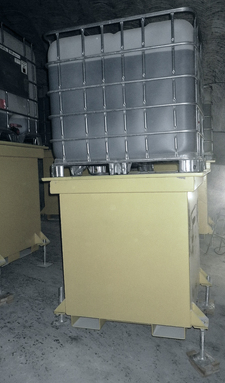Operator removes radioactively contaminated brine in front of chamber 12
Pumping out of brines enables next step in the retrieval of the waste and in emergency preparedness
Radioactively contaminated brine accumulated over years in front of an emplacement chamber in the Asse mine the handling of which had not been clear is now being removed and processed further.
The Federal Office for Radiation Protection (BfS) has initially pumped out altogether around 17 cubic metres of brine in front of chamber 12 on the 750-m level of the Asse mine and has the brine taken to special collecting containers in another part of the mine. The brine is to be further processed to salt concrete in the mine. The removal of the brine enables the next step in the retrieval of the waste from the Asse mine. Besides it makes emergency preparedness easier.

![]() Specially prepared collecting containers could collect the entire volume of one transport container
Specially prepared collecting containers could collect the entire volume of one transport container
New law on Asse enables management of brine
Management of the brine becomes possible on account of the new law on Asse (Lex Asse) passed by the Bundestag. The law permits the storage of radioactively contaminated substances and further usage for as long as the ten-fold of the exemption limit – up to this limit the handling of radionuclides does not need to be licensed nor reported – is not exceeded and the health of staff and population is not put at risk. This is the case with the brine in front of chamber 12.
Processing of the brine to special concrete in the mine
Previously it was only possible to manage the brine via special paths, e.g. by taking it to the Lower Saxon federal state collecting depot. In the past, the federal state collecting depot stated that it did not have sufficient capacity for accepting the brine. It was therefore impossible to store the brine there. The brine can now be processed to special concrete in the mine. The radioactive substances will be bound into solid matter for as long as it takes until they have decayed. Processing can and will start after the law has entered into force.
Origin of the brine
The brine originates from waters that had initially entered the mine in the process of backfilling the potash mine openings of the northern flank. Then they diffused into the area of the emplacement chambers, from where they reached the ground area in front of chamber 12.
Interim storage in specially prepared collecting containers
The brine is being transported to a drift on the 725-m level which has been especially constructed for this purpose. There it is stored within a newly established radiation protection area. It is additionally secured with the help of specially prepared collecting containers. In the unlikely event of a leakage, the collecting containers can collect the entire volume of one transport container each, thus preventing a contamination of the ground area.
Preventing contamination
The area in front of chamber 12 which has now been dried, has been concreted with a special type of concrete, the same applies to the ground area around the swamp. On the one hand, this is to prevent the swamp from filling with brines again and, at the same time, to ensure that possibly existing contamination from this area cannot be taken to other areas of the mine.
Further work now possible
Among others, the pumping out and securing of this area will enable the following works:
- The next step of the trial phase for retrieval, the exploration of chamber 12 by drilling into it.
- The blind shaft 3 located in this area which has no mining function any more can be backfilled with Sorel concrete.
- It will be possible to backfill the roof cleft in the near vicinity of this blind shaft 3 which is to improve the stability of this area of the mine.
Milestone for retrieval and emergency preparedness
By pumping out the radioactively contaminated brine, an important milestone has thus been reached for both the further retrieval of the radioactive waste and for the establishment of emergency preparedness.

